

Locally grown
Chamber programs develop leaders




Chamber programs develop leaders

NTCA members are committed to protecting you
Everyone should take cybersecurity seriously, managing passwords and being aware of all the possible threats to your personal information, finances and more. That’s not meant to frighten you, because you do have help. NTCA member providers across the nation take your security as seriously as you do, and they work daily to secure the networks bringing you the critical internet-based services you need. Recently, I had the opportunity to share more about NTCA’s cybersecurity efforts for both consumers and broadband providers, including CyberShare: The Small Broadband Provider ISAC, through a meeting with U.S. Cybersecurity and Infrastructure Security Agency Director Jen Easterly.
CISA recently launched the Secure Our World program to raise awareness about cybersecurity best practices and empower the public to take proactive steps to protect themselves online. Resources available to the public include a public service announcement, tip sheets on topics like phishing, multifactor authentication and the importance of creating strong passwords and updating software. And there is even a bingo board to make this critical topic engaging for the youngest internet users.
Also, Cybersecurity Awareness Month each October highlights these important issues and emphasizes that you’re also part of the team helping keep us all safe. While NTCA members work behind the scenes, you can help by recognizing phishing attempts, choosing strong passwords and more. Visit cisa.gov/secure-ourworld for more.
Together, we’ll help keep everyone safe and secure online.
From work and school to games and streaming entertainment services, access relies on passwords. The U.S. Cybersecurity and Infrastructure Security Agency suggests you consider using a reliable tool to manage these key bits of information — password managers.
Memorizing complex passwords for multiple accounts is difficult, or impossible. So, sometimes passwords are too simple and easily hacked. Password managers, though, can help.
A password manager is a software tool that organizes all your passwords. Then, a single master code unlocks this vault — encouraging use of long, complex passwords.
Web browsers, including Safari, Chrome and Edge, have built-in password managers, and these can be accessed across devices like computers and phones. These may suffice for those with only basic needs, but they are limited. For instance, passwords in Apple’s Safari aren’t accessible on an Android phone running Google Chrome.
For more robust options, there is software like LastPass, 1Password and Bitwarden. These work across multiple types of devices and have additional features, such as the ability to generate passwords and integration into your favorite web browser.
Make your master password long, reliable and unique. Sixteen characters is recommended. Also, regularly review your stored passwords to remove passwords for accounts you no longer use.

Readers today can find themselves facing a technological conundrum. While many book lovers treasure traditional books, electronic devices, designed to make reading more comfortable and accessible, are hard to ignore.
For some, there’s nothing like the sensation of holding a book and feeling the paper as the pages turn. Printed books will always have emotional, if not monetary, value as collectibles. And they certainly aren’t going anywhere.
These days there are countless options of things to download and read on our phones and tablets, but dedicated, handheld electronic book readers, often called e-readers, offer text and lighting customizations and many other conveniences to enhance the reading experience. Nonreflective, electronic-ink displays give them a paper-like look and make it easier to read outdoors compared with reading on a phone or tablet. And, dedicated e-readers present fewer distractions — you won’t be interrupted by notifications, calls or texts.
Over the past few years, the price of e-readers has fallen while the hardware has improved. High-end features, such as backlit, high-resolution screens and waterproofing, are standard. If you don’t have an e-book reader, there’s never been a better time to invest in one.
• Portability: E-readers are lightweight and can store thousands of books.
• Customization: Most allow you to adjust the font and size, background
lighting, etc. They can make reading accessible for individuals with visual impairment by providing text-to-speech and other customizations.
• Searchability: E-readers’ built-in search functions mean you can easily find a favorite quote or passage in the book.
• Built-in resources: Dictionaries and thesauruses allow for immediate definitions.
• Environmentally friendly and affordable: No trees are harmed in e-book production, and they usually cost much less than traditional books.
Amazon Kindle is synonymous with e-reader for good reason. According to both Wired magazine and The New York Times’ Wirecutter, the Kindle is the most affordable, best and easiest choice for reading electronic books.
• Amazon Kindle: With a 6-inch screen and a high pixel density for sharper text, the least expensive Kindle — around $100 on Amazon — offers just about all the advantages of the more expensive e-readers. If you’re planning on reading outdoors this summer, it’s worth the extra charge, roughly $50, to upgrade to the waterproof Kindle Paperwhite with its better lighting options.
• Rakuten Kobo: Japanese retailer Rakuten currently offers six Kindlecomparable e-readers ranging from $110 to $400. The Libra 2 has a physical page-turn button and Bluetooth
support, so you can connect headphones and listen to audiobooks.
• Barnes & Noble Nook: The book retailer’s e-reader features a touch screen and page-turning button, as well as the ability to annotate and highlight text. The devices start around $100. As an added perk, Nook owners can read the complete contents of any book for free while in stores for one hour per day.
Once you’ve settled on an e-reader, where do you find the books? Amazon, Barnes & Noble and Kobo all sell tomes to download to their specific e-readers. But you could read for years without having to spend another dime. Sources of free e-books include:
• OverDrive.com, used by 43,000 libraries and schools worldwide, allows anyone with a library card to pull e-books, magazines and audio books.
• Project Gutenberg, a library of more than 70,000 free e-books to download or read online. Thousands of volunteers digitize and proofread the books available at gutenberg.org.
• Mybookcave.com
• Planetebook.com
• ManyBooks.net
• OpenLibrary.org
• GetFreeEbooks.com
We’re in the dog days of summer. Did you know that phrase dates back to the Romans? When I hear it, I always think about long, hot days perfect for a dip in a creek or pool, or a family gathering beneath a shade tree. It’s a time of year bookended by two of my favorite holidays — the Fourth of July and Labor Day.
 JEFF EATON General Manager
JEFF EATON General Manager
One of the many things I enjoy about my role with SCRTC is seeing all the ways our community comes together. We’re more than a communications company. We not only want to provide you industry-leading services — like internet as fast as the summer is hot — but we also have a deep, lasting commitment to helping this place we call home thrive.
There’s no better time than summer to experience the energy, bustle and cherished traditions that make being outdoors so enjoyable. From the Fourth of July with fireworks that light up the night sky to Labor Day and its laid-back barbecues, these holidays are benchmarks in the rhythm of the year. But they go beyond the festivities and events. They carry a deeper significance, a reminder of the values we hold dear and the ties that unite us.
For us, the Fourth of July isn’t just about celebrating independence. It’s about coming together as a community to honor our shared heritage and celebrate our freedoms. Whether it’s an annual parade or a neighborhood party or church potluck, these traditions are uniquely our own. We see family and friends often enjoying the same events and places as our parents, grandparents and even older generations. Throughout it all, we also remember those men and women who served our nation, because we would not be where we are as a community or nation without their service and sacrifice.
And then there’s Labor Day, a time to pause and reflect on the hard work and dedication that built our community and the nation’s economy. Workers play vital roles in our past, present and future, and we’re proud our services make much of this work possible. Often the economies of rural places like ours are dismissed, but we see the work and commitment that make the businesses in our region possible. These efforts are worth celebrating every day.
But perhaps what’s most remarkable about these holidays — really this entire summer season — are the connections we make along the way. In a world that often feels increasingly disconnected, the traditions tie us not only to this place but also to each other, and we’re all the better for it.
At SCRTC, we’re acutely aware of the role we play in fostering this sense of community. It’s a responsibility we welcome, whether that means providing access to high-speed internet, supporting our schools, sponsoring a game or any other service we can provide. Together, we make this place all that it is, and I look forward to seeing you out and about during the dog days.

The SCRTC Community Network is a bimonthly newsletter published by South Central Rural Telecommunications Cooperative © 2024. It is distributed without charge to all customers of the cooperative.
South Central Rural Telecommunications Cooperative is a member-owned corporation dedicated to delivering advanced telecommunications technology to the people of Central Kentucky, including Adair, Allen, Barren, Edmonson, Green, Hart, LaRue, Metcalfe, Monroe, Nelson and Warren counties.
South Central Rural Telecommunications Cooperative, Inc.
1399 Happy Valley Road • P.O. Box 159 Glasgow, KY 42142-0159 270-678-2111 • www.scrtc.com
SCRTC BOARD OF TRUSTEES
Ralph J. Thompson, District I Bonnieville and Munfordville exchanges
Billy Smith, District II Canmer and Horse Cave exchanges
Tim Coomer, District III Cave City and Hiseville exchanges
Ronnie Tucker, District IV Center, Edmonton and Summer Shade exchanges
Kevin Bradshaw, District V Glasgow and Temple Hill exchanges
Zack Kender, District VI Fountain Run, Gamaliel and Lucas exchanges
Anthony Wells, District VII Buffalo and Magnolia exchanges
Jeff Eaton, General Manager
Bobby H. Richardson, Attorney
Produced for SCRTC by:
On the Cover:

The chambers of commerce in LaRue, Barren and Metcalfe/ Edmonton counties offer thriving leadership programs. Sandy Kidd is executive director of the LaRue County Chamber.
At home or at work, it’s frustrating when all your devices can’t connect to Wi-Fi. SCRTC Broadband Plant Technician Nathan Maness is often asked about signal quality and Wi-Fi’s range.
While a Wi-Fi router can extend the reach of your fast, reliable internet service, there are potential speed bumps. Radio waves are at the heart of that Wi-Fi connection. Interference, physical obstacles and distance can all degrade the signal.
“It all depends upon the size of the home and what the home is built with,” Nathan says. “Brick walls and additions to homes can really hurt the Wi-Fi signal, and that’s where a mesh network can make a huge difference.”
Unlike traditional Wi-Fi setups that rely on a single router, an SCRTC mesh network uses multiple access points to provide a stronger signal over a greater distance while also improving reliability and technical support.
l Metal objects positioned near the router
l Metal mesh embedded in plaster walls
l Microwaves, fluorescent lights, cordless phones and some external computer monitors
l Bluetooth devices
l Distance
“No router is ‘plug and play,’” Nathan says. “They all have some type of setup to complete. With a router from SCRTC, we handle that process for the customer, and leased equipment provides a greater quality of service to the customer.” The Managed Wi-Fi Solutions program solves the most common network hassles.

by
SCRTC technicians take the time to understand your unique needs, creating a solution perfect for your location. Because router technology changes so quickly, SCRTC provides both the skill and hardware needed to reliably keep all your devices online and performing at their peak.
Key features of a Calix carrier-grade residential router:
l Gigabit-capable system
l Wi-Fi 6 with 802.11 AX technology
l Remotely manageable by SCRTC
l Four ports for direct connections

l $5 a month for router, additional AP/ mesh extenders are $3 monthly
l Three times faster than the previous generation
l Handles more devices
SCRTC has launched a business-grade internet called Hosted Wi-Fi Solutions. Every company has a unique space and varied internet demands — from employee workflows to customers’ needs. A more robust network is needed to handle that traffic. Our Hosted Wi-Fi Solutions program is the answer, providing gigabit speeds instead of gridlock.
BENEFITS OF HOSTED WI-FI SOLUTIONS
l Customizable and scalable architecture
l Advanced network optimization l Automatic updates Call 270-678-SAFE (7233) to find out more about equipment and pricing.


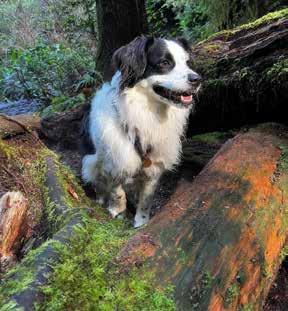 Story by KATHY DENES
Story by KATHY DENES
Summer typically means travel time, whether scenic road trips or flights to vacation destinations. And more than ever before, beloved pets are tagging along for the ride.
Pet-friendly travel is a hot topic. It’s addressed by top vacation resources like Conde Naste Traveler, which has an online list of nationwide hotels and Airbnbs it deems best for accommodating pets, especially dogs. On travelandleisure.com, search “pets,” and you’ll unleash a wealth of helpful articles.
Even financial companies are weighing in.
NerdWallet compiled a list of Best Hotels for Pets in 2024, based on factors like fees and amenities, and rated air travel options, topped by Alaska Airlines. But if you don’t want to do the research yourself, there are travel agencies that specialize in planning and taking care of the details for you.
Hotels, resorts, parks and campgrounds usually post their pet policies, fees and amenities, as do airlines, trains and even cruise lines that allow passengers with paws. There are also numerous websites focused entirely on petfriendly travel, across the nation and around the world. Just browse by city, state or destination at resources such as:
• bringfido.com
• petswelcome.com
• tripswithpets.com








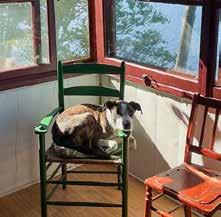

“Before deciding to bring your pet along on a trip, you need to ask yourself whether or not it’s in your pet’s best interest to do so,” says Dr. Rena Carlson, president of the American Veterinary Medical Association.
What’s a fun adventure for us might be overwhelming for our pets. “If you choose to include your pet, a pre-trip veterinary visit is a good idea, to make sure your pet is healthy and up to date on vaccinations and microchip registration, and to obtain a health certificate, which is required by law if you’re traveling to a different state with your pet,” Carlson says.
Your veterinarian can also provide vital information about the risk of parasites and other diseases that your pet may be exposed to at your destination, as well as possible preventive steps or treatments.
“Make sure to plan for their comfort in transit, whether by land or air, with regular breaks and by choosing the least stressful travel options,” Carlson says. “Confirm in advance that your destinations are pet-friendly, and try to maintain your pet’s routine as much as possible to help them feel secure. Your careful planning can ensure a safe and enjoyable trip for everyone involved.” For more great tips for traveling with your pet, check out: pettravel.com petfriendlytravel.com avma.org
Whether taking your pooch along for a carriage ride in Charleston — child’s ticket required if Fido won’t fit in your lap — or entrusting it to doggie day care at Dollywood while you ride the Mystery Mine, the Southeast is loaded with places that welcome four-legged travel buddies.
Here are a few destinations that receive high marks from people traveling with their pets:
• Little River Canyon National Preserve atop Lookout Mountain in North Alabama welcomes dogs parkwide, but they must be leashed.
• Chattanooga has inviting options, from downtown patio dining and parks to mountain trails and attractions.
• Dinosaur World in Cave City extends a Kentucky welcome to leashed dogs and provides water stations.
• Barkwells, gated retreats in Asheville and Brevard, North Carolina, have dog-centric cabin and cottage rentals, each with a fenced yard and a range of amenities to make it a haven for both pets and people.
• For South Carolina excursions, check sciway.net’s pet travel guide for info on rentals, parks, beaches, eateries and more.

• St. Augustine, Florida, gets a nod from AAA for pet-friendly options, like strolls, visits to popular attractions and perhaps a stay at the historic Bayfront Marin House.



Forget the gas station bouquet. Mikayla Groce’s mission is to bring fresh flowers and eco-conscious practices to Greensburg. She is channeling that mission into Pine Knot Flower Farm, where she grows a variety of flowers and greenery, all with the environment in mind.
“I want to provide local, sustainable flowers to our community,” Mikayla says. “I think that local is the best. You’re supporting local families, but then you also get the best quality flowers.”
Mikayla has always been drawn to flowers. After earning a degree in environmental science, she worked on a farm owned by her husband Zach’s family. When her daughter, Acrey, was born nearly three years ago, she decided to jump into the world of flower farming. “People just imagine the flowers in the summer, but it is full-time farming,” Mikayla says.
The Groces live on a 27-acre farm, the perfect backdrop for Pine Knot. Mikayla uses around a quarter of an acre for her flowers. About half of the remaining acreage is leased to another farm that grows
hay, while the Groces have left the rest undisturbed as a habitat for wildlife.
That decision was made, at least in part, thanks to Mikayla’s environmental science studies. “We thought that it would be best for the land to give it a break,” she says. “I try to be as sustainable as I can with our farming practices.”
The flower-farming year begins in the fall, when Mikayla plants her spring-blooming bulbs. During the winter, usually in January, she starts sowing seeds for spring and summer flowers. “Even whenever everything is cold and dead, things are growing inside for me,” she says.
The first blooms usually appear in April, and the season stretches into October.
Mikayla grows a large variety of blooms and greenery, from tulips to zinnias and beyond. She makes a point of growing extra flowers to attract pollinators and birds, and in the fall, she leaves flowers standing so birds can enjoy the seeds.
She uses Facebook and Instagram to connect with her customer base. Most of her advertising is done through Facebook.
Right now, the majority of Mikayla’s colorful inventory goes to custom orders, whether it’s for a smaller event like a birthday party or larger affairs like weddings. This year, she hopes to provide flowers to local businesses to sell, so it’s easier for the community to access her product. In the longer term, she has plans to open her farm to visitors.
And, in September, a new farmer will join the family when Acrey becomes a big sister. Mikayla says farming with her daughter by her side has been the most rewarding part of operating Pine Knot.
“It has been so much fun to farm with her,” Mikayla says. “It’s really been the best part, just getting to see her play in the dirt, pick flowers — and do it all with her.”
For information about Pine Knot Flower Farm, find the business on Facebook and Instagram.
 Photography courtesy of Pine Knot Flower Farm
Photography courtesy of Pine Knot Flower Farm


‘Cave Wars’ and collaboration are part of national park’s historyStory by LAZ DENES
Spurred by the popularity of Mammoth Cave — the world’s longest subterranean showplace with more than 400 miles of trails and passageways — developers throughout the surrounding area fought tooth and nail to get a piece of the tourist action at caves of their own.
In 1921, almost a century after Mammoth Cave began offering tours, a rival developer named George Morrison fired the “shot heard ’round the cave world.” By blasting a back door to Mammoth’s colorful confines and calling it the “New Entrance to Mammoth Cave,” his business thrived, as it also did for some 20 other rival cave operators. Most were near the 80 square miles of scenic beauty that officially became Mammoth Cave National Park in July 1941. The competition continued, but over the next two decades many caves closed, others were incorporated into the park, and the remaining owners realized it would be more beneficial to work together.
Now at over 52,800 acres, Mammoth Cave National Park remains Central Kentucky’s flagship tourist destination. More than 630,000 guests passed through its gates in 2023, according to Chris Clark,

a lifelong caving enthusiast and a park guide since 2012. Depending on the time of year, visitors can choose from 10 to 12 cave tour options. The tours vary by duration, distance and level of difficulty, and include an accessible tour for individuals with physical disabilities, limited mobility or those who just would rather not navigate stairs. No matter the tour, guests are treated to the stunning sights and sounds of Mammoth Cave, millions of years in the making.
“This part of Central Kentucky is known for its karst topography, which means it’s rich in underlying dissolvable rock,” Chris says. “We’re blessed here with limestone, and as sinkholes have developed over time, it’s allowed for the
collection of water that has worked to create the incredible passageways we’re able to tour today.”
The two-hour, 2-mile-long Historic Tour is most popular among tourists, Chris says, as it features the area of the cave that established it as a bona fide showplace.
The two-hour Domes and Dripstones Tour exposes visitors to a higher concentration of stalactites and stalagmites and begins through Morrison’s infamous “New Entrance.” Chris’s favorite is the threehour, 3-mile Violet City Lantern Tour.
“I first came here when I was 6, and I said that day I will work here someday,” Chris says with a laugh. “I just didn’t realize it would take until 2012. I love my job.”


Wearing a plaid shirt and a gray Froberg’s Farm cap, Tyler Froberg shares a cool fact about a favorite fruit with youthful viewers. “Every strawberry in the world is picked by hand,” he tells eager young minds. “And it takes half an hour to pick one row.”
Most fruit and vegetables are harvested by machines, which helps the fourth-generation farmer talk about farming as a STEAM — science, technology, engineering, arts and math — career option he promotes in a video for Lego’s education branch, known as Rebuilding the World with Agriculture.
Tyler has made a few videos for Lego, promoting schoolbased projects like building a strawberry-picking machine that won’t destroy the delicate fruit. But his screentime isn’t
limited to collaborations with Lego. As Farmer Froberg, Tyler has more than 780,000 social media followers learning about gardening, farming and life on a fruit and vegetable agritourism farm.
TEACHING THROUGH VIDEOS
When he first got out of the Army, Tyler worked on the family farm in Alvin, Texas. “I decided that I had my GI Bill, so I should probably go to college,” he says.
After earning a degree in agriculture, he worked for a year as an agriculture science teacher. “I loved it, and when you love something, you tend to be good at it, and when you tend to be good at it, you get recognition for it,” he says.

“I think I achieved something that I never thought I would through social media.”
— Tyler Froberg @farmer.froberg
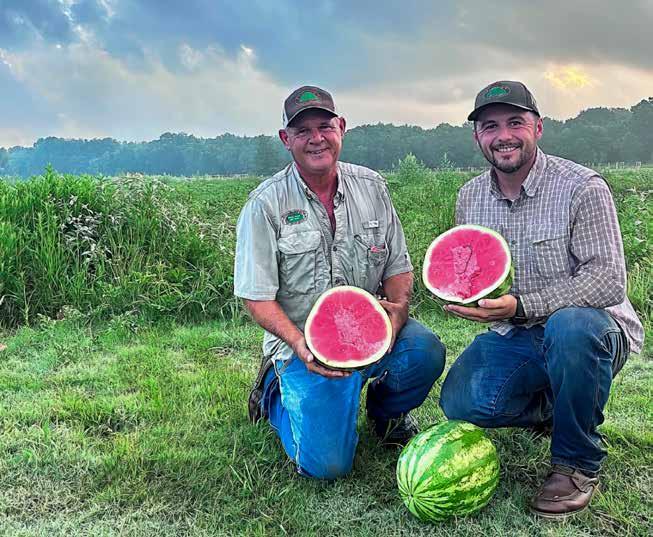
A nonprofit recognized Tyler as the person it needed to run a program teaching farm skills to fellow veterans. “When I was there, though, I missed the spark that you got with young people, whether it was seeing a seed germinate or seeing an animal being born,” he says. “While I was teaching adults, I didn’t see the same spark.”
Around that time, TikTok became popular, and Tyler got an idea. “I should make little videos, like ag lessons,” he says. “I’m still a teacher, and maybe that will scratch that itch. And so, I did.”
In the first two months, several of his videos got a respectable number of views. “I had a video hit 10,000 views, and then I had a video hit 250,000 views, and I was like, ‘Huh, there might be something to this.’”
Tyler has posted a few poems, tried growing square watermelons and loofahs, and succeeded in growing star-shaped zucchini. He’s even zipped layers of jackets to the tune of “Stand by Me” — which got over 5 million views the first time he posted it. But his favorite videos to make are any with his sons in them. “We just laugh and have fun,” he says, talking about “Little Frobergs” Dusty, Carson Lee and Tommy “Tomcat.”
“I’m not one of those content creator parents that are like, ‘No, no, no. You have to say that this way,’” he says. “It’s only been three years, and so, it’s still kind of new for us. They get excited to go out and film with me.” Tyler’s wife, Kristi, known on social media as “Momma Froberg,” also gets the occasional guest spot.
Tyler’s made plenty of silly videos. His personal favorite involves being a rubber duck farmer. “There were these rubber ducks everywhere, and it was just a lot of fun,” he says.
Despite his following on social media, Tyler doesn’t consider himself an influencer. “Influencers are putting on makeup trying to influence you to use this certain brand or product, or there are ag influencers who create content for people in the ag industry. They work with brands and influence followers to use certain brands or products, and I don’t feel like I do that.”
Tyler says there are a few stages every content creator goes through. The first step is embarrassment. “You don’t want anybody you know to know that you’re creating content,” he says.
LEFT: Tyler, right, and his uncle, Alfred Froberg, show off watermelons grown at Froberg’s Farm. BELOW: Tyler enjoys making social media videos with his sons, or, as he calls them online, “Little Farmer Frobergs.” Tyler and his son, Dustin, have fun sharing gardening lessons.
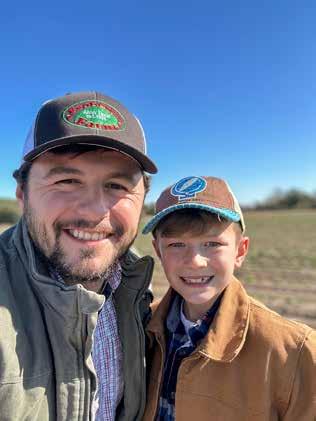
“Then comes, ‘So you’re still doing that thing?’” he says. “That’s when you see your mom and she’s like, ‘Oh, you’re still making the little videos. It’s so cute.’”
The third phase is thinking content creation is a waste of time. “You’re starting to take it more seriously,” he says, “but you’re not getting a lot out of it yet.”
Then there’s the final step — success. “For me, I got invited to give a commencement speech at a college graduation, and walking out on stage and realizing, ‘oh wait, I think I did it.’ I’m still not 100% sure, but I think I achieved something that I never thought I would through social media.”
What about those strawberry-picking machines?
“I would like to think that Lego went as far as they could with that and got hundreds of thousands of submissions for strawberry-picking machines, but I don’t know that to be true,” he says. But he planted the seed of an idea. Now it’s time to see what grows.
Tyler Froberg’s videos are available on Instagram and TikTok at farmer.froberg. His YouTube and Facebook accounts are under the name Farmer Froberg. For more on his family’s farm, go to frobergsfarm.com.


If you’ve ever wanted to drive farm machinery as big as a house, hear the steady hum of countless sewing needles on a factory tour or visit a funeral home — without traveling there in a hearse — you’re in luck.
Three distinct leadership programs through the chambers of commerce in LaRue, Barren and Metcalfe counties give current and emerging leaders an insider’s view of their local communities, along with networking experience and leadership skills.
For Katie Billingsley, Mary Ann Forbes and Sandy Kidd, the experiences not only enhanced their professional lives, the months-long development programs taught them information about their communities beyond what’s known by many lifelong residents.
“Some days we might visit 10-15 different places. It’s so many different things they wouldn’t necessarily do as part of their normal routine,” says Sandy, executive director of the LaRue County Chamber of Commerce and a 2015 graduate of its program. “We also try to build relationships within the group for networking opportunities.”
Katie, a 2015 alumna of the Barren County Chamber of Commerce program, agrees the leadership program makes for lifelong relationships. “It’s going to be an experience that you’ll never forget, because of the camaraderie you come out of with your graduating class and all the new things you learn about your community,” she says. “It’s exciting to be part of the change in the community and know that we’re always evolving.”

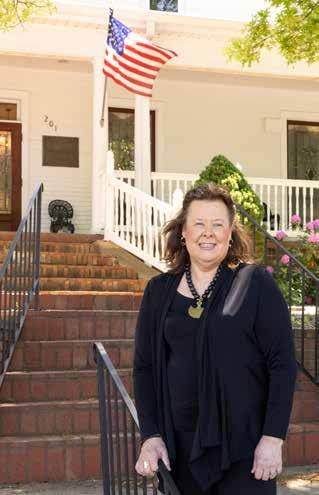
While each program is focused on leadership, they all go far beyond business lessons and personality assessments. Days are planned on topics like history, tourism, manufacturing, health care, state and local government, utilities, agriculture, education and entrepreneurship.
FAR LEFT: Katie Billingsley is a leadership program graduate and founder of Entertain Glasgow, which hosts community events.
LEFT: Sandy Kidd is executive director of the LaRue County Chamber of Commerce.
BOTTOM: Mary Ann Forbes attended the first chamber leadership class in the area in 1999.
“I was born and raised in Nebraska, and I moved to Glasgow in 2013,” Katie says. “I was always known to have a good work ethic, and everybody kind of knew my last name. When I moved here, I didn’t realize how hard it would be to find a job. After applying to many places and having several failed interviews, one of the interviewers said, ‘You had a great interview, and I understand not being from here. The best advice I can give you is, get involved.’ That’s when I started with the chamber, and it absolutely changed my local career journey.”
Regardless of age or experience level, participants in these programs quickly realize there’s always more to learn and new ways they can give back.
“I’m from Metcalfe County, and aside from going to college in Bowling Green, I’ve never really left the area,” says Mary Ann, past president of the Metcalfe/ Edmonton County Chamber of Commerce and a graduate of its first leadership class in 1999. “I always wanted the best for the citizens here. There’s not a whole lot of revenue in small towns, but I wanted to help provide the best life possible for everyone here.”
With the help of her connections made through the leadership program, she’s accomplishing her goal. “There were always a lot of late nights and countless volunteer hours to make it happen,” Mary Ann says. “But it was all worth it.”
Many participants also help with a service project to offer a helping hand in the community. “We redecorated, painted and refurbished the chamber office from front to back as my service project,” Sandy says. “Other groups have made repairs to local walking trails, new basketball goals in parks and fundraising projects. The entire community benefits from these programs.”
Perhaps best of all, participants express a common theme each year. In addition to new leadership principles, many also learn something about what makes their community great.
“It’s always amazing how many people see the hidden gems in our communities for the first time,” Sandy says. “So many people talk about how they’ve lived here their entire life, but they didn’t know what was at the end of the street.”
Graduates learn that leadership is about accepting limitations and knowing when to ask for help. “You can’t do it all by yourself,” Sandy says. “A good leader is someone who includes others and asks for their opinions. We all know that who you know is part of what it takes to get things done.”
The programs stress a key part of effective leadership is helping others grow — something local chamber graduates have tried to do.
“The chamber has the best networking group our community has to offer,” Katie says. “It taught me who I need to talk to in the community to get things done. It takes everybody in the community to make it what it is, so I never want to take anything for granted.”

Among summer’s many charms are vegetables and fruit blooming with flavor, and it doesn’t take a lot of effort to turn them into delicious salads.
These recipes cover all the salad bases. From crisp leafy tossed salads to sturdy mixes that can sit out for a couple hours while the kids play in the yard and you visit with friends. Keep it easy and choose a makeahead recipe featuring hearty pastas, grains and beans that can work as a side dish or a full meal, or throw together fruit or vegetable combinations that hit sweet or savory notes.
Summer salads are versatile, so feel free to swap out lettuces, and use a variety of fruits instead of just one kind. After all, it’s summertime, and the living — and cooking –should be easy.

Food Editor Anne P. Braly is a native of Chattanooga, Tennessee.
1 pint fresh blueberries
2 peaches, diced (leaving the skin on adds texture, vitamins and color)
2 cucumbers, sliced 1/2 cup crumbled feta cheese
3 tablespoons fresh lemon juice
1 tablespoon Dijon mustard
1 tablespoon honey
1 tablespoon olive oil
1 tablespoon finely chopped basil Kosher salt and freshly ground black pepper, to taste
In a large serving bowl combine the blueberries, peaches, cucumbers and feta.
In a jar with a lid or measuring cup combine the lemon juice, Dijon, honey, olive oil, basil, salt and pepper. Whisk together until well combined.
Pour the vinaigrette over the salad and gently mix everything together. Taste for seasoning and garnish with extra basil. Serve or cover and refrigerate the salad until ready to serve.

3 cups corn kernels (approximately 4 ears)
1 cup cherry tomatoes, quartered
1 cup cucumbers, diced
1 cup crumbled feta cheese
1/4 cup red onion, diced
3 tablespoons olive oil
3 tablespoons rice vinegar
1 tablespoon fresh parsley
Fresh basil ribbons
Kosher salt and freshly ground pepper, to taste

Bring a large pot of salted water to a boil and add the corn. Cook for 3 to 4 minutes or until the kernels turn bright yellow. Drain the corn and cool completely. Use a sharp knife to remove the kernels from the corn cob, scraping the cobs to get all the “milk” from the cobs.
In a large bowl, combine the corn kernels, cherry tomatoes, cucumbers, feta cheese and red onion. Drizzle the olive oil and vinegar over the salad.
Season generously with salt and pepper, to taste, and toss well to combine. At this point, the salad may be made ahead. Just before serving, sprinkle with fresh herbs, and toss to combine.
Grilled chicken heightens the flavor of this salad.
2 (10-ounce) packages cheese tortellini, prepared according to package instructions
2 cups shredded chicken
1 cup halved cherry tomatoes
8 ounces fresh mozzarella pearls
1 cup roasted red bell peppers, chopped into 1/2 -inch pieces
1 cup basil pesto (store-bought or homemade)
1 1/2 tablespoons extra-virgin olive oil
Fresh basil ribbons, for garnish
In a large bowl, combine the tortellini, shredded chicken, cherry tomatoes, mozzarella, roasted peppers, pesto and olive oil. Cover and refrigerate. Can be prepared up to a day ahead. When ready to serve, top with fresh basil.

2 pounds shrimp, peeled and deveined
2 tablespoons finely chopped red onion
1 rib celery, finely chopped
Dressing:
1 cup mayonnaise
1 lemon, zested and juiced
2 tablespoons chopped fresh dill
1 tablespoon Dijon mustard
1 garlic clove, minced
1/4 teaspoon kosher salt
Pinch of freshly ground black pepper
Bring a pot of water to a boil. Add the shrimp and boil for 2 to 3 minutes, until cooked through and pink. Plunge the cooked shrimp in an ice water bath to cool. Meanwhile, make the dressing: Stir together the mayonnaise, lemon juice and zest, dill, mustard, garlic, salt and pepper. In a mixing bowl, stir together the cooled shrimp, red onion, celery and dressing, until creamy. Serve plain or nestled on butter lettuce leaves garnished with fronds of fresh dill, if desired.

1399
SCRTC installers optimize your network to maximize Wi-Fi range — best-in-class performance right in your home.
l Gigabit-capable system
l The latest technology standards
l Remote management by SCRTC
l Automatic firmware upgrades to optimize performance

Upgrade to a cutting-edge Calix GigaSpire router for the best network connectivity — $5 monthly. Each additional access point is only $3 monthly.
Call 270-678-2111 or visit scrtc.com for more information.

